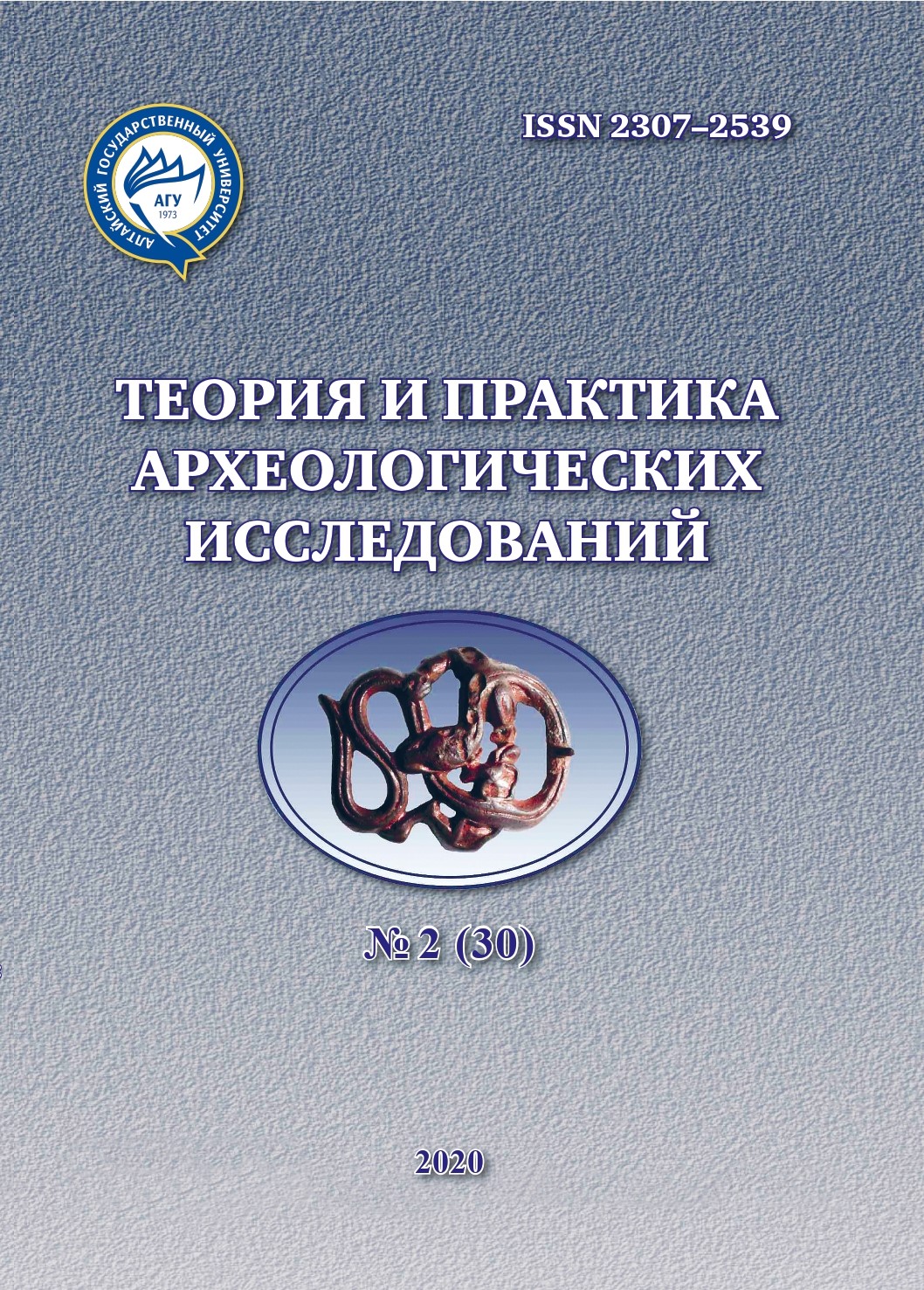ИЗНАЧАЛЬНЫЙ ДЗЁМОН, ЯПОНСКИЙ АРХИПЕЛАГ: ХРОНОЛОГИЯ И НЕКОТОРЫЕ ОСОБЕННОСТИ КАМЕННОГО ИНВЕНТАРЯ
Abstract
Jomon is the Neolithic epoch on the Japanese Islands. It is dated between 13800–2400 BP and is divided into six periods. During the first period – Incipient Jomon (13800–10000 BP) – along with the appearance of the most ancient pottery the significant changes in the stone tool-kit took place; the Paleolithic blade and microblade techniques disappeared; hunting weapon modified with the wide utilization of bows and arrows; bifacial points evolved; a number of wood-working tools, including the instruments with ground edge appeared. At the same time there appeared local peculiarities of stone assemblages which are visible between northern and southern, inland and coastal parts of the archipelago. Lithic experimental researches help to figure out the specific of the various techniques and labor expenditures during the wood-working tools making and the efficiency of their use. By the end of this period (about 10000 BP) the stone tool-kit acquired features that are characteristic of the entire subsequent Jomon epoch.
Downloads
Metrics
References
Okladnikov A.P. Neoliticheskie pamyatniki kak istochniki po etnogonii Sibiri i Dal’nego Vostoka [Neolithic Sites as Sources on the Ethnogony of Siberia and Far East]. Kratkie soobshcheniya Instituta istorii material’noj kul’tury [Brief Messages of the Institute of Material Culture]. 1941. Vyp. IX. Pp. 5–14.
Okladnikov A.P. K voprosu o drevnejshem naselenii Yaponskih ostrovov i ego kul’ture [Towards the Question of the Earliest People of the Japanese Islands and Their Culture]. Sovetskaya etnografiya [Soviet Ethnography]. 1946. №4. Pp. 11–33.
Tabarev A.V. Dal’nevostochnaya al’ternativa (eshche raz o putyah i vremeni pervonachal’nogo zaseleniya amerikanskogo kontinenta) [Fareastern Alternative (One more time about the routes and time of the initial peopling of the American continent)]. Rossijskij arheologicheskij ezhegodnik [Russian Archaeological Yearbook]. 2012. №2. Pp. 103–147, 169–171.
Tabarev A.V., Ivanova D.A. Pogrebeniya, keramika, rakovinnye kuchi: iz istorii izucheniya pamyatnikov epohi Dzyomon, Yaponskij arhipelag [Burials, Pottery, Shell Mounds: from the History of the Tesearch of Jomon Epoch Sites, Japanese Archipelago]. Gumanitarnye issledovaniya v Vostochnoj Sibiri i na Dal’nem Vostoke [Humanities in Eastern Siberia and Far East]. 2018. №2. Pp. 36–42.
Beginning of the Jomon Culture. What Took Place in 15,000 Years Ago? Tokyo: National Museum of Japanese History, 2009. 187 p. (In Japanese).
Gibbs K., Jordan P. A Сomparative Perspective on the ‘Western’ and ‘Eastern’ Neolithics of Eurasia: Ceramics, Agriculture and Sedentism // Quaternary International. 2016. V. 419. Pp. 27–35.
Hinata Caves. Archaeological Research on the Incipient and Initial Jomon Period. Yamagata: Tohoku University of Art and Design, 2019. (In Japanese with English Summary). Ikawa F. The Continuity of Non-Ceramic to Ceramic Cultures in Japan // Arctic Anthropology. 1964. V. 2. Pp. 95–119.
Kaner S., Taniguchi Y. The Development of Pottery and Associated Technological Developments in Japan, Korea, and the Russian Far East // Handbook of East and Southeast Asian Archaeology. New York : Springer, 2017. Pp. 321–345.
Keally C.T., Taniguchi Y., Kuzmin Y.V. Understanding the Beginnings of Pottery Technology in Japan and Neighboring East Asia // The Review of Archaeology. 2003. V. 24. P. 3–14.
Lithic Assemblage from Western Terrace of Hinata Cave. V. I: Spear Points Workshop in the Incipient Jomon. Sendai : Tohoku Gakuin University, 2006. 136 p. (In Japanese with English Summary) Morisaki K., Natsuki D. Human Behavioral Change and the Distributional Dynamics of Early Japanese Pottery // Quaternary International. 2017. V. 441. P. 91–101.
Mikoshiba Site. Excavation and Research at a Site Transitional from the Terminal Late Paleolithic to the Incipient Jomon Period. Shimaki Shoseki Publishing Center, 2008. (In Japanese with English Summary). Miyazaki H., Keally C.T. A Terminal Pleistocene Salmon-Fishing and Lithic Worksite at Maeda Kochi, Tokyo, Japan // Current Research in the Pleistocene. 1986. V. 3. P. 96–97.
Morisaki K., Oda N., Kunikita D., Sasaki Y. Sedentism, Pottery and Inland Fishing in Late Glacial Japan: a Reassessment of the Maedakochi Site // Antiquity. 2019. V. 93. Pp. 1442–1459.
Morse E. Traces of Early Man in Japan // Nature. 1877. V. 17. P. 89.
Nanatsuguri Site. Excavation of a Late Palaeolithic and Early Jomon Site. Shinano-machi Board of Education, 2008. 72 p. (In Japanese with English Summary). Odai-Yamamoto I Site Excavation Team. Archaeological Research at the Odai Yamamoto I Site. Tokyo: Odai-Yamamoto I Site Excavation Team, 1999. 114 p. (In Japanese).
Omoto K., Takeishi K., Nishida S., Fukui J. Calibrated 14C Ages of Jomon Sites, NE Japan, and Their Significance // Radiocarbon. 2010. V. 52, №2–3. Pp. 534–546.
Sato H., Natsuki D. Human Behavioral Responses to Environmental Conditions and the Emergence of the World’s Oldest Pottery in East and Northeast Asia: an Overview // Quaternary International. 2017. V. 441(B). Pp. 12–28.
Shimamuro O., Toya K., Tanaka K., Nakamura Y., Mochizuki A., Tsutsumi T. Kokajihara site Karasawa B Site: Transitional Lithic Industries of the Terminal Upper Palaeolithic to the Incipient Jomon // Archeological Monographs. Shimae Shoseki Publishing Center, 2009. 69 p. (In Japanese with English Summary)
Sugihara S. Radiocarbon Dating on Archaeological Materials from Natsushima Shell Mound in Kanagawa Prefecture // Sundaishigaku. 1962. V. 12. Pp. 119–22. (In Japanese)
Tsutsumi T. Origins of Pottery and Human Strategies for Adaptation During the Termination of the Last-Glacial Period in the Japanese Archipelago // The Origins of Pottery and Agriculture. Kyoto : International Research Center for Japanese Studies, 2002. Pp. 241–262.
Tsutsumi T. MIS3 Edge-ground Axes and the Arrival of the first Homo sapiens in the Japanese Archipelago // Quaternary International. 2012. V. 248. Рp. 70–78.
Yamanuochi S. Classification and Subclassification of Jomon Pottery // Prehistoric Archaeology. 1937. V. 1. Pp. 28–32. (In Japanese)
Yanshina O. V. The Earliest Pottery of the Eastern Part of Asia: Similarities and differences. Quaternary International. 2017. V. 441. Pp. 69–80.
Theory and Practice of Archaeological Research is a golden publisher, as we allow self-archiving, but most importantly we are fully transparent about your rights.
Authors may present and discuss their findings ahead of publication: at biological or scientific conferences, on preprint servers, in public databases, and in blogs, wikis, tweets, and other informal communication channels.
Theory and Practice of Archaeological Research allows authors to deposit manuscripts (currently under review or those for intended submission to ABS) in non-commercial, pre-print servers such as ArXiv.
Authors who publish with this journal agree to the following terms:
- Authors retain copyright and grant the journal right of first publication with the work simultaneously licensed under a Creative Commons Attribution License (CC BY 4.0) that allows others to share the work with an acknowledgement of the work's authorship and initial publication in this journal.
- Authors are able to enter into separate, additional contractual arrangements for the non-exclusive distribution of the journal's published version of the work (e.g., post it to an institutional repository or publish it in a book), with an acknowledgement of its initial publication in this journal.
- Authors are permitted and encouraged to post their work online (e.g., in institutional repositories or on their website) prior to and during the submission process, as it can lead to productive exchanges, as well as earlier and greater citation of published work (See The Effect of Open Access).








2.jpg)




